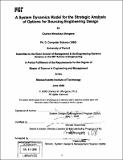A system dynamics model for the strategic analysis of options for sourcing engineering design
Author(s)
Ufongene, Charles Mmaduka
DownloadFull printable version (60.04Mb)
Other Contributors
System Design and Management Program.
Advisor
Donald Rosenfield.
Terms of use
Metadata
Show full item recordAbstract
EC (Engineering Change) is the natural by-product of the Engineering Design process. There are two types of EC: Revisions and Defects Correction. Revisions arise because Engineering Design is an iterative process, requiring Engineers to implement necessary Revisions to the design of a product or systems to improve performance measures. Defects on the other hand are pure design errors, and arise from the fact that the Engineering Design work is not being accomplished with Perfect Quality. These Defects must therefore be corrected in what is termed Rework. EC is the critical factor in determining Lead Time and Labor cost of an Engineering Design work. The generation of Rework - requiring EC depends on several factors including : Quality, Design Complexity, Time to Discover Rework, Time for Issues Resolution, Hiring New and less experienced staff and Over Time work. This thesis presents a Systems Dynamics Model which incorporates these factors as exogenous variables to enable the simulation of their impacts on endogenous variables such as Lead Time and Labor costs. Since these factors exhibit wide variability when the Engineering Design is accomplished In-House compared to when it is Outsourced, the model is therefore a tool that can help an OEM in the Strategic Analysis of Options for the Sourcing of Engineering Design work. A simulation example is given in which an Engineering Design with 474 Initial Designs required 400 fully experienced Engineers to accomplish in 360 Days and a quality level of 52% (the Baseline case). The OEM had only 200 fully experienced Engineers on hand. Facing a staff capacity constraint, this OEM therefore explores a number of In-House Sourcing Options (Hiring and Over Time) and a number of Outsourcing Options (Suppliers with staff capacities of 400 to 1,000, and low (40%) and high (60%) Quality levels. (cont.) The analysis concludes that there are three factors that have major impacts on the viability of Outsourcing. First, when the volume of work to be accomplished is high, Outsourcing of engineering design is a viable option. However, as the complexity of the design increases, outsourcing of engineering design becomes increasingly less attractive. Finally, the analysis found that supplier quality is critical to successful outsourcing. Outsourcing to regions with low labor rates is attractive for labor cost reduction, but do not solve the problem of poor supplier quality with negative impact on Lead Time.
Description
Thesis (S.M.)--Massachusetts Institute of Technology, System Design and Management Program, 2008. Includes bibliographical references (p. 128-131).
Date issued
2008Department
System Design and Management Program.Publisher
Massachusetts Institute of Technology
Keywords
System Design and Management Program.